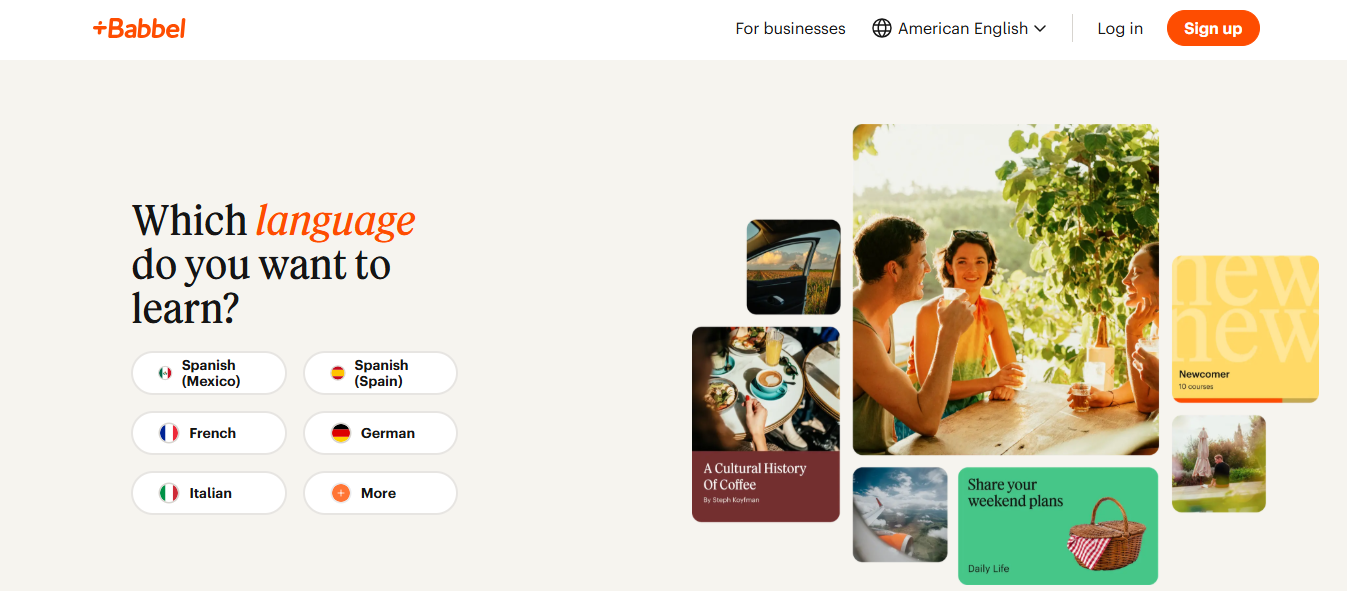How Much Does Babbel Cost? How to Decide if the Price Is Right for You

Michael Xing, Founder of Pingo AI
You are comparing top language learning apps and wondering whether Babbel deserves your time and money. Many learners encounter the same issue: clear lessons are offered, but confusing price options exist across monthly plans, annual plans, trial periods, and per-language fees. This article breaks down Babbel subscription plans, pricing tiers, discounts, refund policies, and monthly costs so you can compare value for money and decide if the price is right for you.
To help with that, Pingo AI language learning app shows clear price comparisons, highlights current deals and free trial options, and recommends the plan that fits your budget and learning goals. You get simple cost breakdowns and a quick recommendation so you can stop guessing and start learning.
What is Babbel?

Babbel launched in 2007 and was built by professional linguists who prioritized proper conversation over flashcard memorization. Lessons teach vocabulary and grammar in context so learners can speak naturally in everyday situations. The app favors clear structure and cumulative progression rather than game-style rewards.
Who Benefits Most: Beginners and Early Intermediates
New learners and early intermediate students who want a reliable foundation do best here. Lessons are concise and orderly, so learners who prefer a methodical path to communication find steady progress and fewer gaps in grammar and vocabulary.
Languages Offered: Which Languages Can You Study
Babbel currently offers 14 languages:
- Spanish
- French
- German
- Italian
- Russian
- Portuguese
- Turkish
- Dutch
- Swedish
- Norwegian
- Danish
- Indonesian
- Polish
- English
The English course is available for speakers of French, German, Italian, Polish, Portuguese, Spanish, Swedish, and Ukrainian. You can also study some languages through other base languages, for example, Spanish through German.
Lesson Structure and Learning Path: Short, Cumulative, Contextual
After you create an account, you start with a quick self-assessment to identify confidence in skills. Content maps to the Common European Framework of Reference, with levels from A1 up toward C1 depending on the language.
Lessons are short, build on prior material, and mix listening, reading, writing, and speaking. You will see repetition, focused grammar explanations, and role-play style dialogues to reinforce retention.
Flexibility and Topic Targeting: Pick What You Need
Lessons are not strictly linear. You can jump to topics like travel, dining, or business communication without unlocking every prior unit. This lets you target specific situations while still accessing the structured course material when you want a whole progression.
Speaking and Pronunciation Practice: Active Voice Work
Babbel includes speaking exercises and speech recognition to help with pronunciation. Recorded dialogues and simulated exchanges push you to form phrases aloud rather than only recognizing them on screen. Expect practical phrases and gradual expansion of spoken control.
Platform Support and Offline Use: Where You Can Learn
Babbel works on iOS and Android apps and in a web browser. Many lessons are available for offline download so that you can study without a constant connection. Sync keeps progress aligned across devices.
How Babbel Compares: Structured Over Gamified
If you compare Babbel to more game-oriented apps, you will notice less emphasis on streaks and badges and more on clear explanations and real dialogue practice. That design favors steady skill building rather than playful competition.
Practical Tips to Get the Most from Babbel
Spend short sessions regularly, speak aloud every lesson, review the integrated grammar notes, and use the review manager to fix weak spots. Combine Babbel with real-life practice, like language exchanges or short conversations, to accelerate active use of new phrases.
Related Reading
- Top Language Learning Apps
- Babbel vs Duolingo
- How Much Is Duolingo Max
- Rosetta Stone vs Duolingo
- Best Apps to Learn Spanish
- Best Apps to Learn Japanese
- Busuu vs Duolingo
- Duolingo Alternatives
How Much Does Babbel Cost? Pricing Breakdown of Babbel

Website prices and app store prices differ. On the Babbel site, the typical offers are:
- 3 months for $45.75
- 6 months for $80.70
- 12 months for $107.40
The mobile app store listings are usually higher:
- 3 months at $53.99
- 6 months at $80.99
- 12 months at $107.99
Babbel lists a lifetime option at $599 but frequently discounts it to about $299, which includes access to all languages across web and mobile.
Where to Buy: Web Versus App Store
Buying directly from Babbel’s website is usually the cheapest route. Platform fees for Apple and Google often increase in-app prices by roughly 30 percent, which explains the gap between web and mobile totals.
Cost Per Month: Breaking the Math
Convert each plan into a monthly cost to compare the value. The 3-month web plan works out to about $15.25 per month; the 6-month web plan is about $13.45 per month; the 12-month web plan drops to roughly $8.95 per month. Mobile app per-month figures are slightly higher, such as approximately $18 for 3 months, $13.50 for 6 months, and $9.00 for 12 months. If you buy the discounted lifetime at $299, your monthly equivalent depends on how many months you expect to use it.
Lifetime Versus Subscription: Value Check
Lifetime access can be the cheapest over multiple years, especially if you plan to study several languages or keep practicing long-term. Think of it in terms of months: $299 divided by 24 months equals about $12.46 per month. Divide by 48 months, and the monthly cost falls further.
Promos and Partner Deals: How to Save
Babbel runs seasonal sales and occasional partner discounts; third-party promotions sometimes beat the listed price. Some bundles or holiday offers reduce the effective monthly cost on the 6-month and 12-month plans. If you have a promo code or access via a partner, compare the final checkout price on the web against the app store listing before you commit.
Who Should Pick Each Plan?
Short trips and quick refreshers work well with the 3-month option. Learners aiming for steady progress should consider a 6-month plan. The 12-month plan offers the lowest monthly fee among subscriptions, making it suitable for regular daily practice. Lifetime fits multi-language learners or people who want no recurring charges, though it requires a larger upfront payment.
Practical Checkout Tips and Refunds
Check whether your region supports web checkout and local currency pricing to avoid foreign transaction fees. If you buy from an app store, remember that their refund and subscription management rules differ from Babbel’s site policies.
Pingo AI: Speak Fluently with Real Conversations
Pingo's AI language learning app focuses on conversation first practice with expressive AI, adaptive feedback, and two modes tailored for beginners and advanced learners. Try Pingo free and start speaking in real-world scenarios to build fluency and confidence.
Related Reading
- Memrise vs Duolingo
- Best Apps to Learn French
- Lingodeer vs Duolingo
- Pimsleur vs Babbel
- Jumpspeak vs Duolingo
- Best Apps to Learn Mandarin
- Best Apps to Learn Arabic
- Best Apps for Learning English
- Best Russian Learning Apps
What are You Getting for That Price? (Features)

Babbel structures lessons to fit busy schedules. Each lesson runs about 10 to 15 minutes and pairs written prompts with recorded audio and images. You will translate phrases, fill in blanks, and choose answers in multiple-choice formats.
The app uses speech recognition, allowing you to listen and repeat words, which trains pronunciation in real time. Set weekly learning goals, view progress checks, and get reminders to sustain a routine.
Everyday Conversations: Step Into Real Dialogue and Speak Back
This feature presents short dialogues that model everyday situations like ordering food, meeting a colleague, or paying at a store. You can watch or listen with or without English subtitles, then replace one speaker and use speech recognition to speak your lines. Availability varies by language, and when it’s offered, it functions as a direct bridge from scripted practice to live interaction.
Audio Recap: Listen, Test, and Lock In Comprehension
Audio Recap packages run about 10 to 14 minutes and align with specific courses. Each session breaks a dialogue into parts, explains key vocabulary and culture points, plays the whole dialogue again without interruption, and ends with a short quiz to check comprehension. Use these to sharpen listening skills and review lesson material in a context that mimics real speech.
Grammar Guide: Short Rules With Lots of Examples
The Grammar Guide gives concise explanations on topics such as pronouns, irregular verbs, and adjective agreement. Entries are short, example-driven, and targeted at practical use rather than exhaustive theory. Coverage varies by language; for instance, German currently has a limited set of grammar topics, while some languages have fewer or no entries yet.
Review System and Spaced Repetition: Keep Words From Slipping Away
Babbel’s review tools let you revisit vocabulary and phrases through writing, speaking, listening, and flashcards. The review engine uses spaced repetition to schedule reviews at intervals that improve long-term retention. You can run quick review sessions when you have a few spare minutes and track your retention with built-in progress checks.
Mini-Games and Quick Drills: Fast Practice With Variety
If you prefer gamified short bursts, Babbel offers small games and drills to practice vocabulary and grammar. These add variety to your routine and can help reinforce items flagged by the review system, while keeping sessions light and engaging.
Babbel Live Classes: Live Teachers and Scheduled Group Lessons, With Separate Costs to Consider
Babbel Live connects you to an instructor in a scheduled class format. You pick a class that fits your level and schedule and join at the appointed time for teacher-led practice. Live classes may require an additional fee or separate booking, depending on the plan and current offers. Check pricing and whether a class is included with your subscription or billed separately before you sign up.
Podcasts and Babbel Magazine: Extra Listening and Reading Resources
Babbel produces language podcasts and a magazine with learner-focused articles. Podcasts are available inside the app and on platforms like Apple Podcasts and Spotify. Magazine content includes practical tips, cultural insights, and study hacks to broaden comprehension and spark conversation topics with native speakers.
Culture Bites: Short Cultural Videos to Boost Conversation Topics
Culture Bites offers brief videos on customs, food, holidays, and notable figures. Most are in English and designed to give context you can use in conversation. These clips enhance cultural awareness, support language learning, and provide concrete topics to practice speaking.
Payment, Plans, and How Much Babbel Costs: Pricing Options and What to Watch For
Babbel sells time-based subscriptions rather than a permanent license. Typical options include monthly plans, multi-month bundles, and annual plans, which offer a lower cost per month for longer commitments. Promotions and promo codes can reduce the initial price.
Payment Options and Subscription Terms
Payment options commonly include credit card and app store billing, and subscriptions usually renew automatically until you cancel. Look for trial offers, any free trial window, and the provider’s refund or money-back guarantee policy before purchasing.
If you want current monthly cost or specific plan comparisons, tell me your country and whether you prefer monthly or annual billing, and I’ll outline likely options.
Account Management and Billing Details: Control and Flexibility
You can change language courses, upgrade or downgrade plans, and manage auto-renewal in account settings. Cancellation typically stops future billing, but check whether access ends immediately or at the end of the paid period. Watch for in-app purchases such as live class credits that may bill separately from a core subscription.
Accessibility and Platform Support: Use Babbel Where You Learn Best
Babbel runs on iOS, Android, and web browsers, so you can switch devices without losing progress. Offline downloads for lessons can be available on mobile, depending on your subscription and device storage. Speech recognition works best on devices with clear audio input and access to the app’s microphone.
How to Decide Whether the Price Is Right for You

Decide whether the Babbel price matches your goal by naming the skill you want. Babbel focuses on structured lessons, grammar drills, and real-world dialogs, making it suitable for learners who wish to make steady progress in accuracy and useful phrases.
If your aim is casual exposure or flashcard-style vocabulary only, weigh the Babbel subscription cost against free apps that focus on repetition and gamified practice.
Use Frequency: How Often Will You Open the App and Get Value?
Ask how often you will study and how long each session will be. Babbel’s lessons reward regular use through structured progression and a spaced repetition review system, so daily or several sessions per week make the monthly or yearly fee pay off. If you plan to use it once a month, the subscription cost will feel high compared with sporadic free options.
Long Term Value and Plans: Monthly, Annual, or Lifetime, Which Fits Your Timeline?
Compare the monthly and annual plan costs, and check if a lifetime plan is available in your region as a one-time purchase. Think about how many languages you want to learn and for how long.
A short trip or a focused three-month push often favors a monthly plan. Multi-year learning for work or relocation makes an annual plan or lifetime purchase more economical when you calculate the cost per month.
Price Comparison: How Babbel Stacks Up Against Tutors and Other Apps
Match Babbel subscription pricing against alternatives to judge value. Private tutors often charge between 20 and 50 dollars per hour for live conversation and personalized correction.
Other Apps Offer Different Mixes
Some give free core lessons but limit advanced content, while others charge for live tutoring or community features. Babbel buys structured lesson paths, grammar explanations, and review tools for a fraction of regular tutoring if you use it consistently.
Alternatives That Put Conversation First: When to Try a Different App
If your top need is practicing real-time speech, try Conversation First tools or tutor marketplaces. Apps like Duolingo provide a low-cost introduction to vocabulary and daily habits.
Tutor platforms and language exchange apps give live correction from native speakers. AI conversation apps provide instant speaking practice, offering adaptive feedback and personalized exercises for free or at a low cost before you subscribe.
Related Reading
- Best Apps for Learning Korean
- Best Apps for Learning Spanish
- Best Apps for Learning Portuguese
- Best Apps for Learning Spanish
- Best Apps for Learning Russian
- Best Apps for Learning Italian
- Best Apps for Learning German
- Best Apps for Learning English
- Best Russian Learning Apps
Start Learning A Language with Pingo for Free Today

Pingo puts conversation first. Instead of drilling flashcards or repeating set phrases, you speak with an AI that mirrors real-world exchanges. Order food, make small talk, ask for directions, and handle surprises just like you would in real life. The app uses expressive AI to vary tone and phrasing so practice feels alive.
Tailored Practice: Adaptive Feedback and Personalized Exercises
Pingo adjusts lessons to your needs. Exercises evolve from simple prompts to more prolonged interactions as you grow more confident. The system tracks recurring errors and builds personalized drills right into conversation practice. Daily goals and short review sessions fit easily into a busy day and push steady progress without wasting time.